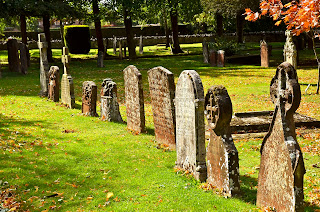Before we left on our latest Scotland adventure, September and October, I wrote that one of my preoccupations on the trip would be to visit bone factories (aka graveyards) in Scotland looking for interesting stone carving on gravestones. Over the six week trip I dragged Anne tombstone hunting in Edinburgh, Peebles, Pitlochry, Muthill, Comrie, Stirling, Perth, Dufftown, Elgin, Duffus, Dunfermline, Amulree, Meigle, Kirkwall (Orkney), St Andrews, several others in Scotland and England, and Dull. Yes, there is an actual village in Scotland named Dull, and the church there and pictish standing stone were anything but dull. In our visits to the cemeteries and church or kirk graveyards I discovered much more than I thought I would. With the help of three credible resources (Understanding Scottish Graveyards by Willsher, A Scottish Graveyard Miscellany by Brown, and How to Read a Church by Taylor) I’ll share some of my findings.
First, graveyards are fascinating on several levels. Artistically cemeteries and graveyards can be a photographer’s wonderland of designs and patterns. Without getting into the details of the stones and carvings, the patterns of shapes and light can let the imagination loose. I like the lines and arrangements of stones as well the way stones fit into backgrounds. Here are several examples of patterns we’ve found in graveyards in Scotland:
and at the parish church in Aboyne in Aberdeenshire the crosses dominate.
Another pattern that appears as you wander through the grave stones is the interplay of vegetation and the stones. Over the years ivies and mosses, as well as larger plants, have grown over, around, and on top of the stone monuments. At the Orphir Round Kirk on Mainland Orkney in the far north we saw these grave markers being swallowed by the bushes,
At Dunphail Church on the way to Forres from Grantown-on-Spey the grave marker wears a quite bushy coiffure,
In the graves of the ruined St Peter’s Kirk near Duffus the moss is replacing the writing on one stone.
Another aspect of church graveyards I find interesting is the historical element beyond the graves themselves. For instance, in the Peebles parish churchyard is an example of a Scottish Watchtower.
A watchtower is a tall structure built so that curators could keep a watch over the fresh graves to thwart would-be grave robbers who liked to dig up freshly buried bodies to sell to doctors and universities for anatomical study. Look into the history of Williams Burke and Hare, known as the West Port murderers, who found it lucrative to not only dig up recent graves, but to dispatch some of the living to provide fresh corpses. To keep the newly departed safe in their graves some local cemeteries would use cast iron or iron and stone mortsafes to make it difficult to dig up a grave (Logierait near Pitlochry).
Ancient history, as well, shows up in some kirkyards. At Midmar Church in Aberdeenshire we saw a neolithic stone circle with the parish cemetery built around it.
On Fife at the Abernethy Church graveyard, next to one of the only two Irish-style round towers extant in Scotland, is a pictish carved stone monument dating back to about the 1100s.
Now we come to the monuments and their carvings themselves. I had seen the carvings on tombstones before and even photographed a few, but I really didn’t know what I was photographing. For instance, I had read or been told (or just made it up and thought I’d read it or been told it) that a skull and crossbones (the pirate flag image) on a tombstone, like the one at Elgin Cathedral, indicated that the departed died of the plague.
As horrible as the plague was, it sort of made sense. Too bad it was completely wrong. I’ll bring up the real meaning of the skull and crossbones later. One of the first things I learned was about the style of crosses we were seeing. The empty cross, one with no figure or decoration, symbolizes that an instrument of torture was defeated or that the victim’s soul has been released (Ripon Cathedral, England).
The crucified Christ cross, of course, is a symbol of resurrection and hope. Another sign of hope is the Easter cross, one garlanded with flowers (Logierait near Pitlochry).
One of the most common crosses in Scottish graveyards is some form of Celtic cross or wheel-head cross (Dunphail Church and Fortingall).
Here the circle is thought to represent the circle of eternity. It also could simply be the result of the influence of the Celtic-revival period of mid to late-1800s. Whatever the meaning, the Celtic-style crosses are some of the most beautiful in the churchyards.
In the next entry, I’ll describe the decorations on the tombstones and their meanings.




















No comments:
Post a Comment